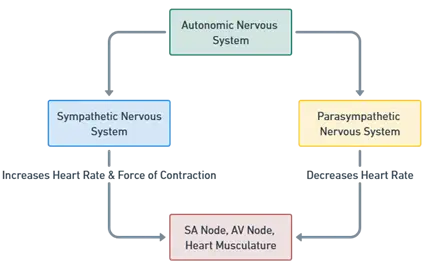- Heartbeat Regulation by the Autonomic Nervous System (ANS)) plays a crucial role in regulating the heartbeat and maintaining cardiovascular homeostasis.
- The ANS consists of two primary branches: the sympathetic nervous system (SNS) and the parasympathetic nervous system (PNS), both of which have opposing effects on heart function.
This is a sample ad placement!
-
Sympathetic Nervous System (SNS)
-
Role:
- Responsible for the “fight or flight” response, preparing the body to react to stress or danger.
-
Mechanism:
- The SNS releases neurotransmitters like norepinephrine, which bind to beta-adrenergic receptors on cells in the SA node, AV node, and myocardium.
- This binding:
- Increases the rate of electrical impulse generation by the SA node (increases heart rate).
- Speeds up the conduction of impulses through the AV node.
- Enhances the force of ventricular contractions (contractility).
-
Effects:
- Increased heart rate (tachycardia).
- Stronger heart contractions to meet the body’s increased demand for oxygen and nutrients during stress or physical activity.
This is a sample ad placement!
-
Parasympathetic Nervous System (PNS)
-
Role:
- Responsible for the “rest and digest” response, promoting relaxation and energy conservation.
-
Mechanism:
- The vagus nerve (cranial nerve X), the primary nerve of the PNS, releases acetylcholine, which binds to muscarinic receptors on the cells in the SA node and AV node.
- This binding:
- Decreases the rate of electrical impulse generation by the SA node (slows heart rate).
- Reduces the speed of impulse conduction through the AV node.
-
Effects:
- Decreased heart rate (bradycardia).
- Reduced force of heart contractions, conserving energy during periods of rest and recovery.
This is a sample ad placement!
Balance Between SNS and PNS
- The heart’s rate and force of contraction are determined by the balance between the SNS and PNS.
- Both systems continuously modulate heart activity to adapt to the body’s needs, whether responding to stress, exercise, or rest.
- Factors such as physical activity, emotional state, hormones, and blood pressure influence the balance between the SNS and PNS, adjusting heart function accordingly.
Thank you for reading from Firsthope's notes, don't forget to check YouTube videos!


